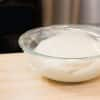Best Climate for Bread Dough
Some bread recipes call for proofing dough at room temperature, others suggest a warm environment, and still others specify a cold environment like the fridge. Is one approach better than another?
The surrounding temperature influences the speed at which dough undergoes its final rise before baking, a step known as proofing. To speed the process, many bread recipes (including some of our own) recommend keeping the dough in a warm place. But what effect does proofing temperature have on the quality of the finished bread? To find out, we proofed three batches of rustic Italian bread in three different temperature zones: an oven preheated to 200 degrees and then shut off, a cool spot outside of the kitchen, and the fridge. Proofing at a cool room temperature (below 72 degrees Fahrenheit) took 2½ hours for the bread to double in size and yielded loaves with a decent brown crust and an even rise. Proofing in the oven took half as long but resulted in loaves with alcoholic aromas, less-browned crusts, and a less-even rise. Proofing in the fridge took nearly 24 hours but produced the best results: loaves with a good rise, complex flavor, darker brown crusts, and chewier, more airy crumbs.
Here’s why: As dough proofs, yeast slowly digests sugars present in the flour and produces alcohol and carbon dioxide gas, causing the dough to rise. However, at higher temperatures, enzymes break down gluten (the protein network that gives bread structure), which forces the yeast to work harder and faster to make the bread rise. In this situation, the yeast must digest much more sugar to create enough carbon dioxide to achieve a decent rise, but this also means more alcohol production. These actions affect the final results in rustic loaves composed of just yeast, flour, salt, and water: Less sugar leads to less surface browning, the additional alcohol production creates boozy tang, and the yeast’s exertions can result in an uneven rise.
To summarize: Unless speed is of the essence, we recommend proofing at a cool room temperature or—if time permits—in the fridge.


